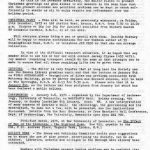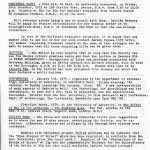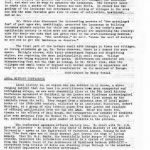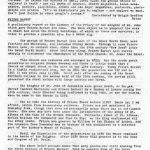Page 1
As this is the December Newsletter, the Editor wishes to present Christmas greetings and good wishes to all members in the deep hope that all the present economic and political problems can be kept in check sufficiently to enable us all to enjoy respite and refreshment over the holiday period.
Christmas Party
This will be held, as previously announced, on Friday 14 December 1973 at 166 Station Road, NW4 from 7.30 to 10.00p.m. tickets at £0.50 (or 30p for juniors) available from Richard Deacon or at the door.
Will everyone please bring a pen or pencil with them. Dorothy Newbury will be happy to receive contributions for her Tombola either at her home or telephone her so that she can arrange collection.
In view of the difficult transport situation, it is hoped that any member able to use his or her car will contact Jeremy Clynes. Any member requiring transport should do the same so that attempts can be made to ensure that all those requiring lifts can be given them.
Lectures
The Editor is very hopeful that at long last the Society can use Hendon library premises again and that the lecture on 8 January on “FIELD ARCHAEOLOGY — Recognition of Sites and problems associated with Motorway Building”, given by Harvey Sheldon and Bernard Johnson, will be held at The Burroughs, NW4 at 8.15 for 8.30 p.m. please note that it is 8th January, as the lecture has been postponed from 1 January which has been declared a public holiday.
Conferences
January 4th – 6th, 1974 — organised by the Department of Archaeology, University of Newcastle, on HADRIAN’S WALL. Friday evening, 4 January, to Sunday lunchtime 6 January. Cost: £8. A new interpretation of many aspects of Hadrian’s Wall: the chronology, the garrisonning and its destruction, to name but a few, will be presented, and the implications discussed. Details from the Hon. Secretary, or from Hadrian’s Wall Conference, Department of Archaeology, the University, Newcastle upon Tyne, NE1 7HU.
29th-31st March, 1974, at the University of Lancaster, on “The Effect of Man on the Landscape — the Highland Zone”. Fee £10, payable to the CBA.
Society News
The Press and Publicity Committee invite your suggestions as to where the new A4 size poster, advertising the Society, can be exhibited. Libraries, schools and colleges in the Borough have already been contacted.
Members with Christmas present buying problems may be reminded that “Blue Plaques of Barnet” which has been reprinted, is available from the Hon. Secretary, price £0.34 (post paid). Supplies of the “Chroniclers of the Battle of Barnet” at £0.21 and of the commemorative Brochure for the Quincentenary of the Battle at £0.20 are also still available (prices include postage).
The Royal Air Force Museum has brought to notice their very interesting Illustrated Guide of the Museum, which costs £0.29 (including postage). Also being sold in aid of the Museum funds are two very attractive Christmas cards, portraying early aircraft flying over snow covered country. These cost £0.05 each and are available from the Museum at Aerodrome Road, NW9 5LL.
Members may like to know that the working hours for the Church End Site have been extended to include Saturday mornings, as the light goes so early in the afternoons during the winter.
Page 2
This means that Saturday and Sunday digging will operate from 10.00a.m. to dusk; Wednesdays from 10.30a.m. to dusk. If members can arrange to share cars sufficiently it is hoped that the petrol restrictions will not prevent numbers keeping steady.
Reports
A thought provoking lecture on “The Changing Face of the English Countryside” was given on Tuesday 6 November at St. Mary’s Church House by Dr. E. M. Yates, Lecturer in Geography at King’s College, London, when those present heard his analysis of three key topics: how the English landscape was formed, the present day forces that are changing the landscape fast, and what can be done to preserve the landscape. The lecturer dealt in depth with a sector of West Sussex and East Hants. He showed how the geology of the landscape had determined the siting of villages in the area and how the same features gave rise to areas of cultivation, heathland, and so on.
Dr. Yates also discussed the interesting paradox of “the privileged few” of past ages who, unwittingly, preserved the landscape by building enormous private estates for their own enjoyment. It was today’s more egalitarian society in which more and more people are exploiting the countryside for their own ends that had given rise to the ever-increasing destruction of the landscape. “The landscape,” he said, “shows the sort of society we are and we get the landscape we deserve.”
The final part of the lecture dealt with changes in towns and villages. As living standards go up, Dr Gates observed, there is a demand for more space. Multiple stores, and the stereotyped fascias and shopfitting styles, are replacing the more individualistic small shops. Village markets are being replaced by car parks. Differences and character are disappearing fast and the time is coming, in Dr Yates’ view, when the villages and small towns of England will become similar in appearance not only to each other, but to their counterparts on the mainland of Europe.
Contributed by Percy Reboul.
Local History Conference
Local history is, as anyone who has dabbled in it knows, a wide-ranging subject that can lead its practitioners down many unexpected and intriguing alleys, as was made abundantly clear at the 8th Local History Conference sponsored at Guildhall by the London and Middlesex Archaeological Society on 17 November. The keynote of variety was first struck by the exhibits around the hall. They ranged from a splendid show of Local guidebooks of the 18th-19th century, collected by an individual historian, Robert Harrison, to a group of clay tobacco pipes from East London and displays of official publications from the GLC and LAMAS. HADAS was there too, thanks to the efforts of Eric Grant, who transported exhibit of booklets plus some material from the Hendon St. Mary’s tombstones survey, and set it up, incidentally selling a good number of booklets in the process.
The conference speakers offered variety too. To start with Dr J. H. Dyos of Leicester — he holds the only Chair in Urban History at any British University — spoke on the Exploration of Victorian London, taking as his text “the Dark ages are at their darkest just beyond the age of living memory”. Then Mr W. J. Smith, the beautifully lucid keeper of Middlesex records, described the information available in a clutch of inventories from the Probate Court of the Archdeacon of Middlesex between 1669-1737 — everything from details of debts and standing crops through to the minutiae of kitchen implements and feather mattresses.
Finally Mr Keith Bailey, of the Wandsworth Historical Society, talked of their work on the operation of the Poor Law in Putney from Elizabethan times to 1834, and his audience entered upon the world of penniless sailors trying to get back to rejoin their ships at Portsmouth, foundlings on doorsteps, workhouse inmates, expectant mothers being hastily hurried on their way lest their imminent offspring should enter the world in Putney and become a charge upon the parish, indigent soldiers back from the Napoleonic Wars and itinerant paupers — the whole spectrum of the underprivileged from the past.
Page 3
Perhaps the most thought provoking of these three speakers was Dr Dyos. Here is one of the most stimulating of his many ideas. He divided the approach to the local history of a Victorian district into three avenues: (a) the business and commercial network; e.g. records of solicitors, builders, land agents, tramway undertakings; (b) the public aspect: local authorities, political parties, etc. (c) private worlds: family networks, leisure groups. None of the three, in his view, has been properly explored in London; but the third has hardly been touched. He recommends it particularly to local historians. He thinks the history of small local clubs and groups should be explored in depth — use all sorts of sources, church magazines, local newspapers, posters, play-bills, school and old boys’ magazines, postcards, photographs and prints. “It’s an historians job to explore — and explore we must. Don’t just follow in other people’s tracks.”
Contributed by Bridgid Grafton Green.
Friern Barnet
A preliminary report on the history of the Friary of the Knights of St. John which gave Friern Barnet its name. The main object is to pinpoint the area and on which had stood the Friary buildings, of which no trace now survives, in order to provide a possible site for a HADAS dig.
The parish of Friern Barnet lies east of the Great North Road, near Finchley and Whetstone and includes Colney Hatch. Through it runs Friern Barnet Lane, an ancient road, older than the fourteenth century “New Road” (later the Great North Road). About half way along, Friern Barnet Lane curves sharply to circumvent the churchyard of the parish church, St. James the Great.
This church was restored and enlarged in 1853; but the South porch preserves an original Norman doorway and there is little doubt that a church or chapel stood on the site in the twelfth century. Today Friern Barnet is a highly residential area, but in 1801 the population was 432 and in 1901 it was still only 11,566. Until well after the coming of the Great Northern Railway in the second half of the nineteenth century, the parish still preserved its rural nature with large estates and farms.
The Knights of St. John of Jerusalem were given South, or Sarnes (?), Barnet (modern Whetstone and Friern Barnet) by a Bishop of London during the twelfth century, the Charter being confirmed by King John, as was the custom, when he came to the throne in the 1199.
Can we take the history of Friern Barnet back before 1199? There is, I am afraid, little firm documentary evidence. Friern was not mentioned in Domesday Book, though that does not necessarily mean that there was no settlement there. The area may have been under the jurisdiction of the Abbey of St Albans at the time of the Norman Conquest. Fritheric, Abbot of St Albans, defied William the Conqueror and fled to Ely; so the King confiscated all the Abbey lands. Friern was granted by William to the Bishop of London, and its omission from Domesday may be because it was considered as a detached part of the Bishop’s Manor of Fulham.
Until the Dissolution of the monasteries in 1539 the Manor remained in the hands of the Knights. After 1539 Henry VIII granted it to the Dean and Chapter of St. Paul’s.
The above brief account shows that many pieces are still missing from the early history of Friern Barnet; this is equally true of his later history after the Dissolution. Various references give flashes of information. Sir John Popham is said to have lived, while Lord Chief Justice of England (1592-1607), at the Manor House; Queen Elizabeth may have stayed there on her travels between London and Hatfield; important people such as Sir Walter Raleigh and Sir Francis Bacon have traditionally been linked with the Manor, but as yet I have not proved these connections.
Page 4
The tenancy picture becomes a little clearer in the eighteenth and nineteenth centuries, but a new problem arises. A large landowner, John Bacon, leased the Manor from St. Pauls in 1783. Plans showed his house to have been south of the parish church. Why, then, is a building to the north of the church (today it is the clubhouse of the North Middlesex Golf Club) labelled as the Manor House from the mid nineteenth century onwards?
We know that the friar’s hospice, near the church, became the Manor House and that Bacon leased and lived in the Manor House, called Friern House. A Field Book and Plan 1780-3 shows his property as lying south of the church. His obituary in the “Gentleman’s Magazine” of 1816 states that he died “at the Manor House of the Old Priory at Friern Barnet.” Lysons, in his “Environs of London” (1795) describes the Manor house as “a very ancient structure” which had undergone many alterations while still retaining vestiges of ecclesiastical buildings, particularly cloisters. Therefore the Manor House, the original home of the friars, was south of the church, in the grounds of the present Friary Park.
What then was the other Manor House, north of the church? The Field Book and Plan suggest an answer. They show that the main building north of the church was called Manor Farm House, occupied at the time of John Bacon’s death in 1816 by his son, John William Bacon. After 1816 the estates were held in chancery and much litigation occurred; there was even a special Act of Parliament. Some time between 1816 and about 1830 John Bacon’s Manor House was destroyed. It seems probable that, the real Manor House having gone, the word “Farm” was dropped from the name of the building north of the church, and this became known as “the Manor House”. The change was probably perpetuated when John Miles, a man of wealth and a public benefactor, bought the Manor Farm property in 1851. It is his lands that now form the North Middlesex Golf Club. The publication of the Ordnance Survey 25 ins. map of Middlesex, surveyed in 1862-3, completed the change of name, by showing the Golf Clubhouse, then the home of Miles, in clear outline, labelled “Manor House”.
This is as far as research has gone at the moment. What I have not mentioned is the number of historical side-tracks which have had to be investigated, in order to ensure that they were not, in fact, part of the main highway of the story. One such, for instance, was the recurring tale of an underground passage, built originally by the friars, from the Manor House to the Church of St. James. This sounded a feasible story, but the so-called “evidence” for it turned out to be that the bricked up entrance to the passage was said to have been seen years ago in the cellars of the Golf Clubhouse — i.e., in the cellars of a house that didn’t exist when the Friars were active.
Although many gaps still remain in the Friary’s story, one important fact has been established — that the site of the Medieval buildings should be sought in Friary Park, not elsewhere. In due course, if the Borough of Barnet agrees, HADAS hopes to carry out a resistivity survey in the Park, and thus to establish further evidence for the monastic site.
Meanwhile, if anyone has knowledge of the whereabouts of manuscripts, plans, maps or other sources of information about Friern Barnet — either Manor or Church — I would be most grateful to know of it.
Contributed by Ann Trewick.
Bowes Park Methodist Church
(At the junction of Bowes Road and Palmerston Road, Bowes Park) The registrar of this church, Mr A. J. New has written to ask if any of our members have had links in the past with the Church. Recently completely rebuilt, the church is anxious to regain contact with scattered friends; further information can be obtained by sending a stamped addressed envelope to Mr New.





